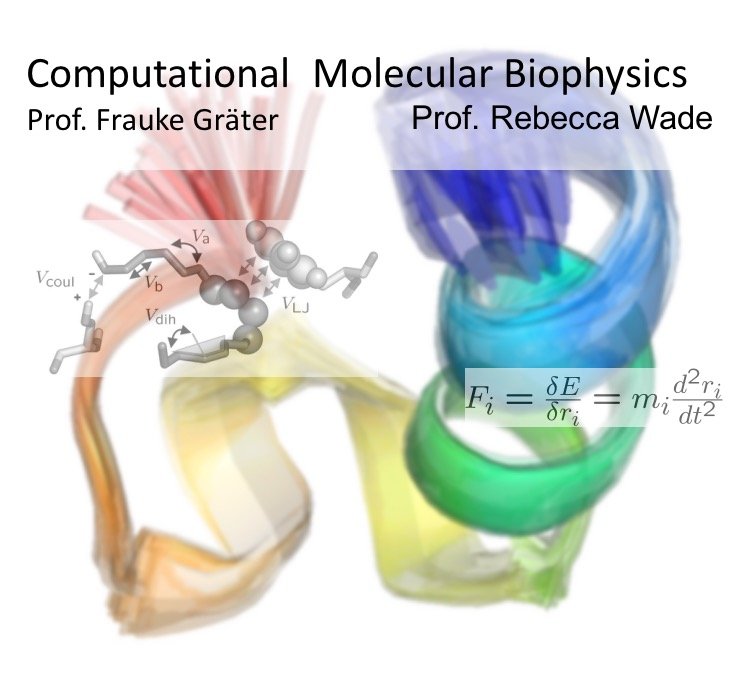Lectures and Hands-on sessions in Computational Biophysics!

How can a bird sense magnetic fields, how does our ear detect sound waves, how does our bone feel gravitation? It is the physics of individual molecules that dictate these and many other processes in life.
This course introduces computational methods to study the structure, dynamics and mechanics of biomolecules at different scales. It aims at endowing the students with an understanding of the principles, the capacity and limitations of different numerical simulation techniques with an emphasis on Molecular Dynamics simulations. The course comprises alternating lectures and hands-on computer tutorials of which the latter are meant to directly demonstrate the principles of running and analyzing computer simulations of biological matter. Lectures and hands-on computer tutorials will take place alternately in the seminar room SR043 and the CIP-Pool (both Bioquant). The lectures/tutorials will take place once a week, on Wed from 4 to 5.30 pm (2 SWS), starting now on October 14, 2015. Lectures will be given by Prof. Frauke Gräter and Prof. Rebecca Wade.
The lectures will be targeted to advanced Bachelor, Master and interested PhD students and will be complemented by hands-on computer sessions in which the students will have the opportunity to run molecular simulations supervised by Dr. Katra Kolšek, Dr. Csaba Daday and Ms. Ana Herrera-Rodriguez.
Lectures:
Introduction
Examples for forces in biology: bone and gravity; birds and magnetic fields; muscle and motors; ears and sound waves
Structure & dynamics of biomolecules (proteins, RNA and DNA)
Mechanics of biomolecules (polymer theories, rate theories, experiments)
Atomistic scale:
Molecular Dynamics I – approximations and force fields;
Molecular Dynamics II – integration schemes;
Molecular Dynamics III – boundaries, electrostatics, ensembles;
Molecular Dynamics IV – probing mechanics;
Monte Carlo
Mesoscopic scale:
Coarse-graining, Go models, Langevin and Brownian Dynamics
continuum approximations
Macroscopic scale:
computational mechanics, finite element methods, fracture theories;
Current challenges: bridging scales, whole virus/cell simulations
Tutorials:
MD: phase transition of argon
MD: structure and dynamics of the protein ubiquitin
MD: mechanics of ubiquitin
Brownian Dynamics
finite-element analysis of DNA mechanics
Resources:
- Schlick, “Molecular Modelling and Simulation”, Springer, 2010
M.P. Allen and Tildesley, “Computer Simulation of Liquids”, Oxford Science Publishers. (Great book with a focus on Molecular Dynamics simulations)
- Frenkel und B. Smit. “Understanding molecular simulation” Academic, San Diego, 2002, (covers MD, MC and Stat Mech)
- Dill and S. Bromberg, “Molecular Driving Forces”, Taylor & Francis Inc, 2010
www.gromacs.org open source molecular simulation software used in the tutorial, for both atomistic MD and coarse-grained Brownian dynamics simulations. Comes with an extensive manual, which includes the principles of MD simulations and biomolecular force fields.
http://cando-dna-origami.org/ web-based finite element software for mechanics/dynamics of DNA sculptures
About HITS
HITS, the Heidelberg Institute for Theoretical Studies, was established in 2010 by physicist and SAP co-founder Klaus Tschira (1940-2015) and the Klaus Tschira Foundation as a private, non-profit research institute. HITS conducts basic research in the natural, mathematical, and computer sciences. Major research directions include complex simulations across scales, making sense of data, and enabling science via computational research. Application areas range from molecular biology to astrophysics. An essential characteristic of the Institute is interdisciplinarity, implemented in numerous cross-group and cross-disciplinary projects. The base funding of HITS is provided by the Klaus Tschira Foundation.